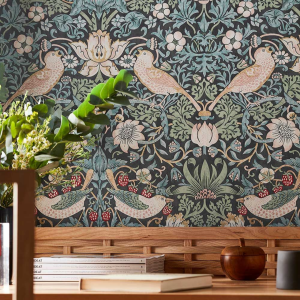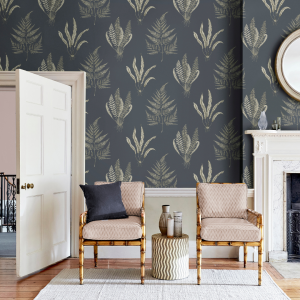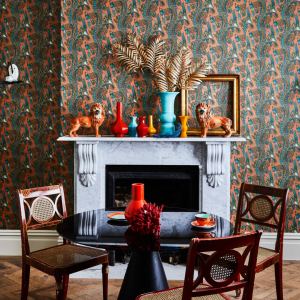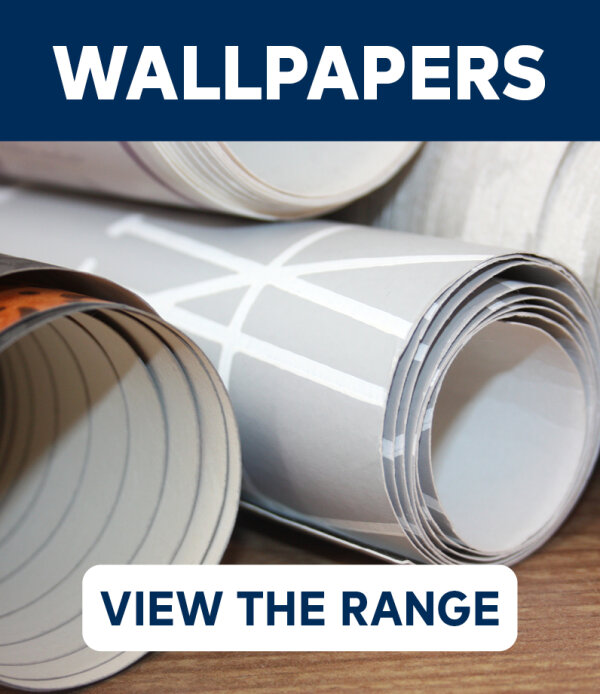How To Hang Wallpaper in 4 Steps

April 23rd, 2024
Now you have browsed our fantastic range of wallpaper, ordered some samples and settled on a design, it's now time to hang it! Make sure your wallpaper rolls has the same batch number before you begin. For advice on how many rolls you require for your space, please speak to a member of the team in store.
You Will Need:
Wallpaper (of course!)
Wallpaper Paste
Wallpaper Scissors
Plumb Line
Knife
Brush
Roller
Paste Table
1. Choose the Right Place to Start.
The traditional method for papering a room is to work away from light, (windows or doors), but you may find it easier to paper the longest uninterrupted wall to get used to the basic techniques before tackling corners or obstructions.
For boldly patterned wallcoverings, take something like a chimney breast as a focal point (choose a suitable wall if there is no chimney) and start the “setting out” from there.
With a bold design, always cut the first length so that when it is hung and finally trimmed top and bottom, there will be a complete motif at the top of the wall.
Before cutting the next lengths, ensure that the pattern matches up with previous ones. Ideally finish in the corner, behind a door.
Top Tip: Find out how best to measure and cut different wallpaper patterns here.
2. Get the Paper Straight.
Few walls are truly square or perfectly vertical. To overcome this and avoid your pattern going askew, mark a vertical pencil line against a plumb line or long spirit level adjacent to where the first length is to hang. Allow the plumb to swing freely until it is at rest before putting a pencil mark down the wall behind the string.
Repeat the process on every wall.
Use a roll of paper to mark the wall one width away from the corner – less 13mm (1/2”) for an overlap onto the return wall – or chosen starting point. Using a plumb line, lightly pencil some guide marks from ceiling to skirting.
Measure your first length, allowing an extra 50mm (2”) at the top and bottom and cut on the table. For best results, ensure the whole pattern appears in full at the top of the wall.
3. Pasting and Hanging.
Paste the Paper Wallpaper:
Lay the wallcovering face down on the pasting table. Mark the top of the paper on the back with a ‘T’ for Top to avoid confusion when you start to hang.
Align the wallcovering with far edge of table, apply paste (especially to the far edge) by brushing away from centre to the far edge, covering in a herring-bone pattern. Take care not to pull the brush over the edge of the paper, getting paste on the surface. When complete, pull the wallcovering to front of table and paste in the same way, ensuring the near edge is fully pasted.
Fold over, slide length on and continue pasting until the full cut length is complete, ensuring a good even coat of paste on the whole of the paper.
For long drops, as on a stairwell, fold the paper concertina fashion. Carry the drop draped over your arm. Always leave paper to soak in accordance with manufacturer’s instructions. Having pasted the paper and allowed it to soak, in line with the manufacturer’s instructions, hang the top fold against the plumbed line and brush out from the centre, working down.
Paste the Wall/Non-Woven Wallpaper:
Paste the paper wallpaper have a different structure to traditional wallpaper and therefore do not need to soak before hanging the paper as they do not expand when wet.
Lay the wallcovering face down on the pasting table. Mark the top of the paper on the back with a ‘T’ for Top to avoid confusion when you start to hang.
Apply wallpaper paste to the wall ensuring there is good coverage across the surface, pasting just beyond the width of your wallpaper.
Hang the first length against the plumbed line and Brush out the paper from the centre, working down.
Top Tip: Take care not to get paste on the surface of the paper as it could damage the finish if not removed. Use a clean bucket of water and a sponge to clean it off the surface. Do not scrub it – let the water in the sponge dilute the paste and absorb it back into the sponge.
4. Trimming
When the paper is smoothly brushed down, run the outer edge of your scissors along the ceiling angle, peel away the paper, cut off the excess along the crease, then brush back onto the wall. Alternatively, use a sharp blade and a straight edge. If using a snap-off blade, change the blade regularly.
At the skirting, tap your brush gently into the top edge, peel away the paper and cut along the folded line with scissors or blade as before, then brush back.
Using a sponge and a bucket of clean water, make sure you remove all the paste from the surface of the paper, skirting and ceiling if necessary. Cut your next piece, allowing for pattern repeat, paste and soak as before. Hang, butting up to the first, taking care to match the pattern.
Do not overlap and continue this process to the next corner.










